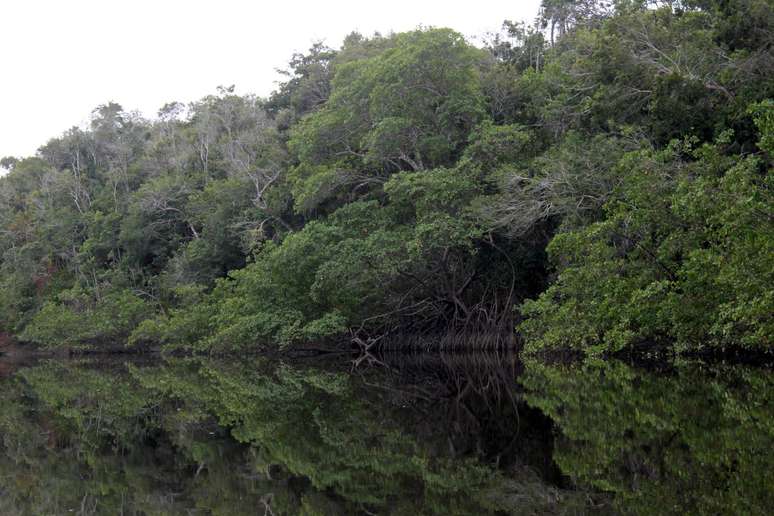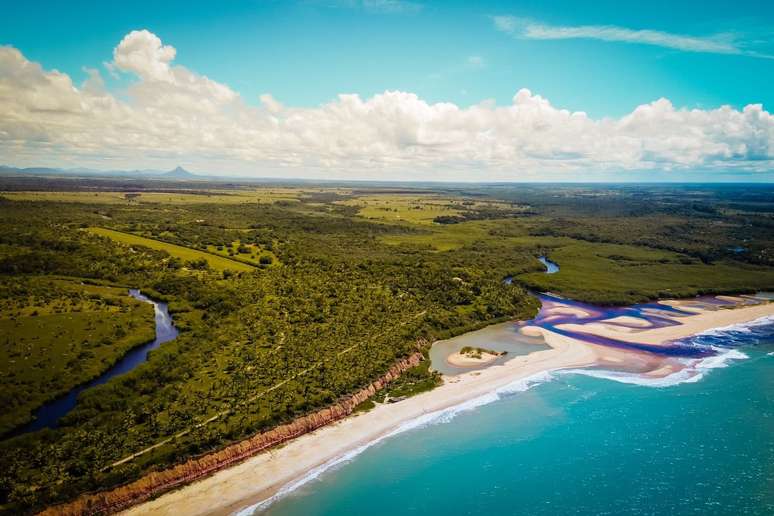Barra do Cahy is more than 22 km from Porto Seguro […]
Long before the invasion of those paradisiacal lands by Portuguese ships, the south of present-day Bahia was already extracting adjectives from the letters and historical accounts of passers-by.
Natural waterfront pools, towering cliffs rising before the sea and a host of other scenery that, until today, can only be seen on foot or by bike.
And Barra do Cahy is one of these destinations.
Located on the north coast of the municipality of Prado, in the extreme south of Bahia, Barra do Cahy has the same appearance it had when the Europeans landed on this side of the Atlantic, on 22 April 1500, whose descriptions referred to deserted beaches and extensive expanses of virgin sand.
Monte Pasquale
“On this day, hours before, we saw the land! Before a great mountain, very high and round; and other lower mountains to the south of it; and a flat land, with great groves: at the high mountain the captain called – Monte Pascoal and to the land – Land of Vera Cruz”.
This is how it is described in the historic letter of Pero Vaz de Caminha, employee of Pedro Alvares Cabral’s fleet, which recorded the arrival in the new lands.
But do you know that story that Portuguese Brazil started in Porto Seguro? Well, that wasn’t exactly the case.
According to historians, Mount Pascoal could not be seen anywhere else in the region, except in Barra do Cahy, about 18 km from Cumuruxatiba. Thus, years later, the thesis according to which Portuguese Brazil began in Porto Seguro would collapse.
“Barra do Cahy, Brazil was born here”
(text on a sign in Barra do Cahy)
Where the sea meets the river, in Barra do Cahy, it is possible to take boat trips along the narrow corridors of the Caí River, crossing mangroves and small forests. From the sea you can still see the historic Monte Pascoal, the first strip of land seen by Portuguese navigators and described in the detailed letter of Pero Vaz de Caminha.
When the Travel by fare There, in the only building in Barra do Cahy, was the Glória restaurant, located on a farm facing the sea, where generous strawberries were served with lobster, shrimp or fish.

At low tide it is not uncommon to see swimmers leaving on foot from Cumuruxatiba, 12 km away, and returning in the late afternoon, with the support of local agencies.
Cumuru, as the neighborhood is known, is also located in the Prado and can be visited with boat trips through the mangroves of Cahy, where the sea meets the Caí River, and Corumbau, the last destination of the municipality, near Caraíva , in Safe Harbor.
As some residents of the region are proud, they have been fortunate not to have paved access like nearby Bahian destinations, such as Trancoso and Arraial d’Ajuda.
HOW TO GET
Two airports in southern Bahia serve as gateways to the region.
The first is located in Teixeira de Freitas, 80 km from the Prado, and receives only Latam flights, the journey of which requires a connection in Salvador, both on the outward and return journey.
Further afield, but with other air options, Porto Seguro is just over 200 kilometers from Prado and has flights operated by Azul, Gol and Latam.
For those who want to go alone, a bus from the Expresso Brasileiro company (expressobrasileiro.com.br) makes three daily departures from Teixeira de Freitas and the ticket for the 2h20 journey costs R$30 (*price indicated on 17/2/24) .
Those coming from the north, by car, must take the BR-101 to Itamarajú and head towards Prado. Motorists coming from the south of Bahia must take the same BR 101 and then BR-418, direction Caravelas – Alcobaça – Prado.
Those traveling in a group can consider renting a private transfer, by car or minibus, such as the one made available by the agency Magical tour of Cumuru (cumurumagicaltour.com.br), which covers the routes Porto Seguro – Cumuruxatiba (4h), Teixeira de Freitas – Cumuruxatiba (2h), Prado – Cumuruxatiba (1h) and Itamaraju – Cumuruxatiba (1h30).
Source: Terra
Ben Stock is a lifestyle journalist and author at Gossipify. He writes about topics such as health, wellness, travel, food and home decor. He provides practical advice and inspiration to improve well-being, keeps readers up to date with latest lifestyle news and trends, known for his engaging writing style, in-depth analysis and unique perspectives.





![It All Begins Here: What’s in store for Tuesday 21 October 2025 Episode 1289 [SPOILERS] It All Begins Here: What’s in store for Tuesday 21 October 2025 Episode 1289 [SPOILERS]](https://fr.web.img3.acsta.net/img/99/48/99481db5c03e1ff295fce95b23125991.jpg)



